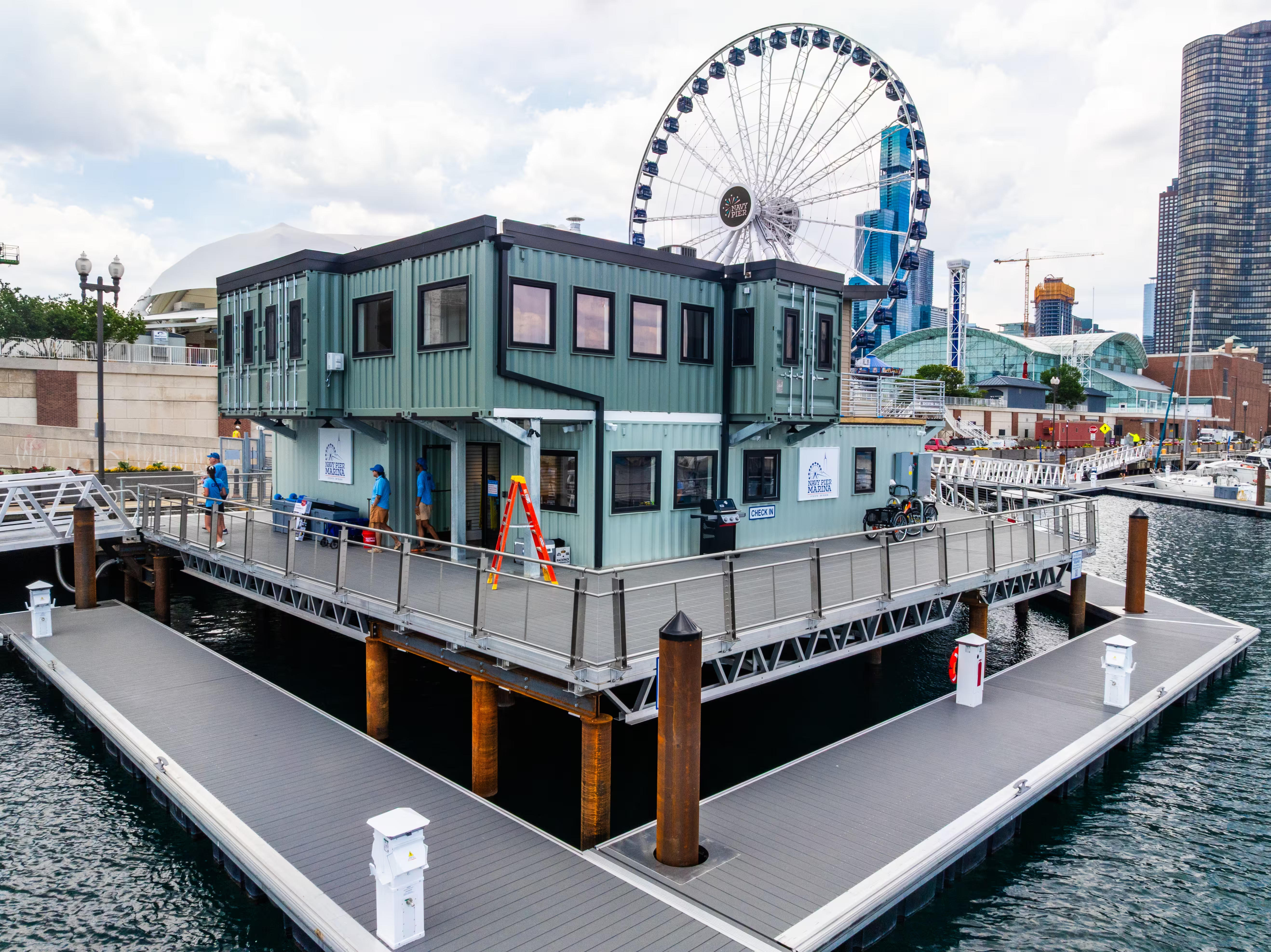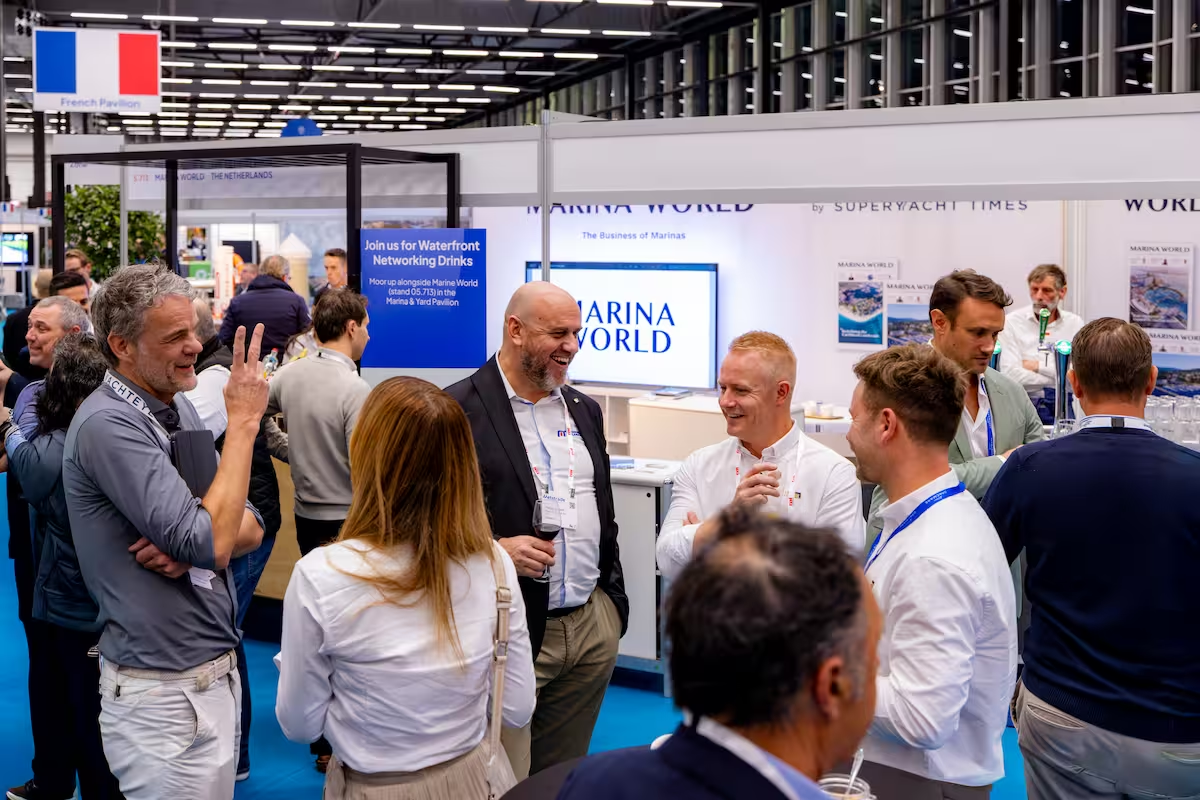Navy Pier Marina is the first new marina in downtown Chicago in nearly fifteen years. Located along the north side of Navy Pier, the most visited tourist destination in the Midwest United States, the facility provides thousands of boaters from Chicago and the Great Lakes access to everything that the city has to offer.
_converted.avif)
The concept of a marina at Navy Pier as the preeminent Great Lakes transient marina was born decades ago. Envisioned by project developer Randy Podolsky, a Chicago-born and raised entrepreneur, avid boater and proud member of the US Coast Guard Auxiliary, Navy Pier Marina is the only privately owned and operated marina on Lake Michigan within the city limits and is setting a new standard for boater service in Chicago. For the first time, boaters can moor alongside the city’s most iconic attractions for just a few hours, an overnight stay or for weeks at a time.
The design of the marina is intended to offer maximum flexibility by providing nineteen piers over 55 metres long that are connected by an 800-metre-long marginal walkway. The individual piers can accommodate individual yachts up to 55 metres, or a mix of up to four smaller vessels. When compared to traditional North American berthing strategies that generally offer a set number of fixed sized berths of varying sizes, this flexible broadside mooring strategy offers a much more adaptable marina that offers many benefits to boaters and operators alike.
Offering berthing to the largest yachts generally found on the Great Lakes - which are rarely larger than 50 metres - is one strength. Although this market segment is currently small in the region, it is growing as facilities like Navy Pier Marina offer berthing for superyachts. No other marina on the Great Lakes can host up to six 55-metre yachts at a time, with the flexibility and adaptability to increase that capacity over time as market demand warrants.
The next major advantage is the ability to mix and match yacht sizes throughout the marina for maximum occupancy and convenience, as well as the ability to adapt to a marina market that is continually evolving. Since there are no set berth sizes, cruisers travelling in groups of boats of different sizes can finally berth alongside one another rather than being split up based on berth size. In most North American marinas, smaller boats will be moored on piers that may be far from their friends on larger boats located on another pier. With the flexible broadside approach, they can not only be moored alongside one another but the marina will never have a vacant berth because it is not the correct size for the boater.
Of particular note was the challenge to design an electrical system that could accommodate a wide range of vessels on various piers, which might need to supply 30 amps, 50 amps or 100 amps to multiple vessels that change every day. A collaborative effort between Maffett Loftis Engineering, Marina Electrical Equipment and the marina operations team provides maximum flexibility for boats of all sizes in as many locations as possible, while also providing future flexibility for charging electric powered vessels.

This flexibility is particularly important on the Great Lakes where the boating season is only 100 days long from May through September. Over the course of the boating season, this allows the marina to support early season fishing tournaments, holiday weekend cruisers, summer sailing regattas, in-water boat shows and special events like the Chicago Air and Water Show. On a day-to-day basis, the marina welcomes any of the 6,000 local Chicago boaters spread across 30 miles (48 kilometres) of the Chicago lakefront to the heart of the city for dinner, a show or shopping on the Magnificent Mile.
“It has been my dream since 1983 to be able to boat to the iconic Navy Pier in the heart of Chicago,” says Randy Podolsky, the Chicago native who is the founder and developer of Navy Pier. “In 2016 it began to take shape and is now a reality open to all recreational boaters and commercial brokers, dealers, clubs and charters. While other marinas in Chicago have limited and often hard-to-reserve transient slips, we have over 100 and can accommodate a vast number of visiting boaters and groups at the same time.”
Engineering
Lake Michigan is more of an inland sea compared to what most often comes to mind when one thinks of a lake. At 500 kilometers long and 128 kilometers wide, Lake Michigan is the fifth largest lake in the world at nearly 58,000 square kilometers. Marinas located on the exposed southern shoreline of Lake Michigan need to withstand waves up to ten metres high. Navy Pier Marina is nestled in the 100-metre-wide North Slip between Navy Pier and a local water filtration facility. These facilities are inside the Chicago harbour breakwater, which is often overtopped by waves as it is less than one metre above the highest water levels. In other words, while there is some protection from the largest storms on the lake, Navy Pier Marina required a hybrid design of fixed and floating structures to provide a safe and calm wave climate for the boaters.
The marina entry is formed by a 90-metre-long floating wave attenuation system. It uses SF Marinas’ four-metre-wide BW400 concrete wave attenuators on the north side, and a 43-metre-long fixed wave attenuation system that forms Pier 1 of the marina to address the largest waves while serving to protect the facility from ice in the winter. Within the marina, behind Pier 1, the marginal walk and Piers 2 through 19 shift to a Structurmarine “Structure 80” aluminium floating pontoon system. The Structurmarine pontoons were selected for their strength, durability, flexibility and aesthetics.
The heart of the marina is the boater amenity building that provides marina offices, ships’ store, restrooms, showers, laundry and a boater lounge with upper level viewing decks. Designed and fabricated by SI Container Builds and repurposing shipping containers into a functional and beautiful structure, it was entirely fabricated off-site and installed in separate components on a fixed pile foundation eight metres above the lake bed.
_converted.avif)
Development
Perhaps the largest challenge to be overcome in the development of Navy Pier Marina was time. The vision was first established in 2016, with the license to develop the marina granted to NPM Venture LLC in 2017. Over the course of three years, the project design and engineering team completed preliminary engineering and obtained all necessary state and federal permits. As final engineering was completed in the spring of 2020, only one final permit from the City of Chicago remained when a change of city administration introduced a four-year delay in the project. While this delay was quickly overcome when Mayor Brandon Johnson was elected, project costs nearly doubled due to pandemic-induced inflation and supply chain issues.
When initial construction bids were received in spring 2024, the project was over budget and at great risk of shutting down. This was until a collaborative effort between the lead engineers Edgewater Resources, contractor JF Brennan and Structurmarine reduced the cost by over $1 million USD through a major redesign in just three months that allowed the project to proceed. The first piles were driven in October 2024, and the first docks were placed in the water in January 2025. In only nine months, working through a bitterly cold winter, the JF Brennan construction team managed to complete the marina in time for opening in June 2025.
The key lessons learned on this project are that persistence on the developer side pays off, and open collaboration and cooperation between the engineering, fabrication and construction teams can achieve incredible results in much less time than a traditional process could. The result is a marina that is setting a new standard for service and quality in Chicago, and finally providing a dedicated transient marina for boaters passing through the city.
This article was also published in issue 150 of Marina World magazine. Click here to read the online version.








